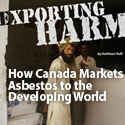In a special Op-Ed for the Ottawa Citizen published on April 17, 2009, Kathleen Ruff and Colin Soskolne criticize the Harper government for their support of the Canadian asbestos lobby. By funding the Chrysotile Institute, the government allows for the lobbyists to support the export of Canadian asbestos to developing countries despite the fact that the substance is an identified carcinogen. While the government argues that asbestos can be safely used under appropriate conditions, this is in stark contrast to a recent Health Canada report that links asbestos to lung cancer risk and denounces the notion that asbestos can ever be used ‘safely’.
Read the full article below.
Supporting a toxic trade
While the federal government is busy cutting funding for real scientific research, it still spends money on the pseudo-scientific promotion of asbestos
The Harper government has come under increased criticism for its lack of support for the scientific community, but it is still funding the pseudo-science of Canada’s little-known asbestos lobby, which is pushing the carcinogen on developing countries around the world.
As reported in the Citizen on April 16 (“Health Canada sat on report tying asbestos to lung cancer,”) it appears the government employs a variety of measures to suppress information on the threat to health posed by Canada’s asbestos.
Like in previous years, this year’s budget committed $250,000 as a “Contribution to the Asbestos Institute to foster the international implementation of the safe and responsible use of chrysotile asbestos.” Over the past 25 years, Liberal and Conservative governments have given the institute more than $19 million as part of what the Canadian Medical Association Journal calls “shameful, political manipulation of science.”
The Asbestos Institute, now known as the Chrysotile Institute, promotes “scientific experts” to champion Canada’s international trade in chrysotile asbestos. It’s a toxic trade. According to the World Health Organization (WHO) approximately 125 million workers worldwide are exposed to asbestos on the job, which results in at least 90,000 deaths every year.
Canada has the dubious distinction of being the second-largest exporter of asbestos (21 per cent of the market) even though we ourselves have virtually banned it. In fact, the federal government is spending hundreds of millions of dollars to remove asbestos from the Parliament Buildings because it’s too dangerous for MPs and their staffs.
Health leaders from across Canada recently asked Prime Minister Stephen Harper to stop funding the Chrysotile Institute, writing “it is a slur on the reputation of the scientific community and people of Canada for the government to be funding such perversion of scientific information.”
The institute, a registered lobbyist for the asbestos industry, changed its name to the Chrysotile Institute in 2004. Most people don’t know what chrysotile is. That’s a plus for public relations. Chrysotile asbestos is the only form of asbestos sold commercially today; 95 per cent of all the asbestos ever used is chrysotile asbestos.
Over 90 per cent of Canada’s asbestos is mixed with cement in developing countries to make roofing for schools and houses. The World Health Organization (WHO) highlights the particular danger of asbestos cement because it gets widely distributed and exposes large numbers of people to risk of asbestos-caused disease.
According to the health leaders, the Chrysotile Institute has put forward “the nonsensical, unsubstantiated claim,” for example, that chrysotile asbestos essentially disappears when it is mixed with cement.
The theory of the magical disappearance of asbestos once mixed with asbestos cement is the brainchild of John Bridle, promoted by the Institute as “the foremost authority on asbestos sciences in the world.”
This is surprising considering that Mr. Bridle has no apparent scientific qualifications. In 2005, he was convicted and fined by a United Kingdom court under the Trades Description Act for falsely claiming on his business letterhead to have a basic minimum asbestos surveyor qualification, when he had failed the exam.
The institute ignores information from the WHO, the International Labour Organization (ILO) and the world scientific community that chrysotile asbestos is a deadly carcinogen that should be banned. The Chrysotile Institute claims that it can be safely used.
Taxpayers might be surprised to know they are funding a political campaign to overthrow the WHO’s policy banning asbestos. In its February 2008 newsletter, the Institute promoted a plan to use “all means available … including repeated and consistent pressure from governments to the Director General (Dr. Margaret Chan) of the WHO,” in order to overturn the WHO’s policy to ban chrysotile asbestos.
Do we want our tax dollars used to sabotage the World Health Organization?
Apart from the integrity question, it is fiscally irresponsible to give Economic Development Canada funds to the Chrysotile Institute to bolster a dying industry. Over 90 per cent of the workers in Canada’s asbestos industry have been laid off; the remaining 550 workers in Quebec have had their wages slashed and work part-year; and in 2007, the remaining asbestos mining company, LAB Chrysotile Inc., filed for bankruptcy protection.
The money would be better spent on viable economic development for the region and assisting the remaining miners and their families.
A recent review in the prestigious medical journal, The Lancet, refers to Canada’s “singularly malevolent role in promoting asbestos use in the developing world.” It’s time for Prime Minister Harper to stop funding “malevolent” misinformation.
The NDP is presently the only party in Parliament to adopt a policy in support of banning asbestos.
At a Victoria town-hall meeting on March 28, Liberal leader Michael Ignatieff acknowledged the double standard whereby the Canadian government is spending millions of dollars to remove asbestos from the Parliament Buildings, while at the same time promoting the export of asbestos to the developing world. “If asbestos is bad for parliamentarians in the Parliament of Canada, it just has to be bad for everybody else,” said Ignatieff. “Our export of this dangerous product overseas has got to stop.”
By April 1, after strong pressure from the asbestos lobby, Mr. Ignatieff did an about face, saying, “We have an obligation to international agreements to the countries that we export to, to make them aware of the risks. That is all I said.” Many of the 300 people in the audience may disagree with that re-interpretation.
It’s time for Mr. Harper and Mr. Ignatieff to end this shameful double standard: Our export of this dangerous product overseas has indeed got to stop.
Kathleen Ruff is a former director of the Court Challenges Program and senior human rights adviser to the Rideau Institute on International Affairs. She is author of Exporting Harm: How Canada Markets Asbestos to the Developing World. Colin L. Soskolne is a professor of Epidemiology in the Department of Public Health Sciences, School of Public Health, University of Alberta.




August 11th, 2009 at 6:20 am
I understand the plite of Quebecois losing there jobs but Canada CAN’T afford the backlash that Harper will get from those countries with there law suits. Harper get your head screwed on strait and ban the export of asbestos, it’s cheaper to compensate Chrysotile then to allow them to murder people. I don’t want to be called a murderer and a hypocrite because Chrysotile ignorance someone please wake up Harper before it’s to late,as it is Canadians are responsable for killing those people. IT’S GOT TO STOP!